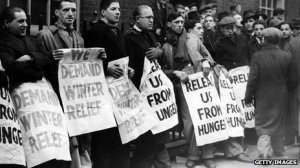The Beveridge Report was published in December 1942 formerly known as the Social Insurance and Allied Services Report. It was named after Sir William Beveridge, a former lawyer prior his position as director of the London School of Economics (LSE). It was seen as the blueprint of the welfare state which supported by an argument involving the state finding a way to deal with the major social matters within the British society. The aim of this report was to combat the five giants, want, idle, disease, ignorance and squalor which were seen as the consequences of the war. It was rumoured (Lister 2004 cited in Alcock 2006: 209) that his plan was backed up by assumptions that oppressed married women were expected to live on a partial amount of their spouses’ earnings. The Beveridge Report also aims to stamp out poverty by providing all citizens a certain amount of support through allowances depending on their income levels (cited in Smith: 118). Beveridge referred his report circulating a code known as the social insurance, which consists a certain sum coming from the wages of workers contributed into a scheme that would help them through hardships which was eventually renamed as the National Insurance (Cited in Alcock 2006: 208 -9).
The Beveridge Report recommended the provision of free health care to meet the needs of people from all backgrounds by building health practices, building public hospitals and more doctors to treat the ill – stricken patients. He recommended funeral allowances that would help with costs for the funeral processes. He also recommended benefits to neutralize the high patterns of poverty among the long – term unemployed, people with disabilities, the elderly, and grants for married women, especially those with children, expectant mothers and those who are from low – income backgrounds. It was believed (Cited in Alcock 2006: 212) that he (Beveridge) recommended the preservation of social assistance along with the national insurance as he acknowledged that some people are less likely to be entitled to claim insurance benefits.
The welfare state commenced to battle the five evils. The Education Act 1944 was introduced to fight against ignorance by providing free education up to the age of 15. The Family Allowance 1945 was introduced to combat want by providing benefits to parents of children as an addition to their incomes along with the National Insurance Act 1946 to provision flat rate pensions and benefits for those who are unemployed and chronically ill through taxation of incomes. The National Health Service Act 1946 to provide free healthcare and the National Assistance Act 1948 to aid people with disabilities and mental health problems. The public housing provision tackled squalor by providing council accommodation and idleness was challenged by industries setting new businesses, creating job opportunities.
As a result of the launch of the Beveridge report, women and members from lower and working class are now entering employment thanks to the distribution of services within health, education and social care at present. Child benefit was seen as a reaction from the compound of the family allowance and tax relief which was obtained by working families with children at present. However, the amount of allowance for single people diverse from those who are married and many people rely on national assistance and amount they receive are low and therefore, are below the poverty trap.
[1] Alcock, P. (2006) Understanding Poverty, 3ed, Palgrave Macmillan Press, Hampshire, Ch14, p208 – 13
Lister, R (1994). ‘She has other duties” – Women, Citizenship and Social Security’, in S. Baldwin and J. Falkingham (eds) , Social Security and Social Change: New Challenges to Beveridge Model, Harvester/Wheatsheaf.
Smith, H. (1996) Britain in the Second World War cited in Unit Materials/Section B Weeks 5 – 12 Poverty to Social Exclusion.

